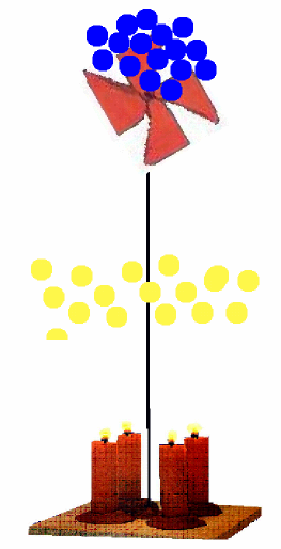Etoys: a tool to change teaching practices
by Fabiana Marella
The project which is described here is integrated in the curriculum for teaching the concept of air convection in fifth grade. The objective of the work sequence was to present the students with several approximations of air convection concepts. Starting from molecular theory, the project also had as a goal to encourage the process of observing, defining a hypothesis, experimenting, and communicating the results. The pedagogical interpretation started with the basic properties of matter: mass and volume, considering its macro- and microscopic dimensions.

Next, we focused on the definition of air, according to the properties indicated, and experimental devices were constructed for the purpose of experimentation and analysis. Again, following the same process, we considered weight, atmospheric pressure, density, and temperature, as properties of matter, and specifically of air. The activity that we presented is part of the learning process that has been transformed by the use of XOs in the classroom. The curricular content was air convection, but a specified goal of the activity was for the students to understand the convection phenomena from the point of view of the properties involved: mass, volume, density, and temperature.
Questions were raised such as: Why does a balloon rise? Or why does a pinwheel turn when it has four lighted candles below? These questions sparked new questions: How does a hot air balloon work? Is there a link between its performance and that of the pinwheel? How could you design an experimental device to observe this phenomenon? In connection with the above, questions were structured for the children to use in their work. The experiments' results did not agree with the explanations given in the previous hypotheses, and the children needed to look more critically at the design of the devices. This encouraged the children to investigate others' work on the subject and through that search they found materials produced by other children on the Internet, as well as academic papers.

Since we didn't have the proper experimental devices available to demonstrate the causes of the air convection phenomenon, Etoys became our tool to model reality, as well as to allow the students to put into play their knowledge and share the results of their work.
The children programmed convection models such as the pinwheel. They made representations of air particles and designed animations to show constant mass, differences in volume, density, and potential energy (both gravitational and kinetic). Through the models, the children finally were able to "demonstrate" and communicate the results of their "research".
Discussion: Afterwards, we drew a comparison chart which exhibited the differences between the work with Etoys and traditional teaching practices.
- Etoys graphics are sharper
- animation replaces note-taking and helps to enliven the phenomenon
- Etoys allows simultaneous and integral understanding of the relationships inherent in the phenomena

Using Etoys to emulate natural phenomena, besides becoming a powerful tool to share completed work, requires the individual to develop a profound understanding of what he or she intends to represent. To program an emulation implies a significant level of knowledge about the physical characteristics of the agents in play (in this case, air particles at constant mass and variable volume, at different temperatures, with different levels of kinetic and potential energy, etc.) In addition, programming requires the individual to grasp and manipulate the cause, effect, and consequence of the relationships implied by the phenomenon being modeled.
For these reasons, we assert that this new learning tool, far from being merely an enrichment device, transforms the teaching/learning mechanic.
It asks more from the learner, because it requires him or her to anticipate steps, and encourages the development of deductive hypothetic thought. Likewise, it brings about inductive reasoning through trial and error. The use of programming-specific language forces the individual to organize thoughts in a logical sentence structure, using if, for, while, do, or, and. Learner-created models give the teacher the opportunity to put the student in a situation to critically analyze the emulation. Contrasting reality and the model enriches the understanding of the subject matter, at the same time allowing flexibility and the possibility to improve on the concept.
Briefly, we brought the computer to the classroom to "teach to learn" within the paradigm of the information age. The challenge is to use the XO to do what cannot be done with pen and paper. Otherwise, we would be turning this revolutionary tool into a conservative one, by allowing it to be absorbed into past practices. In the words of García y Castrillejo, "the challenge is to decide if we are educating to use a tool, or educating for an era of choices". Mtra. Fabiana Marella





